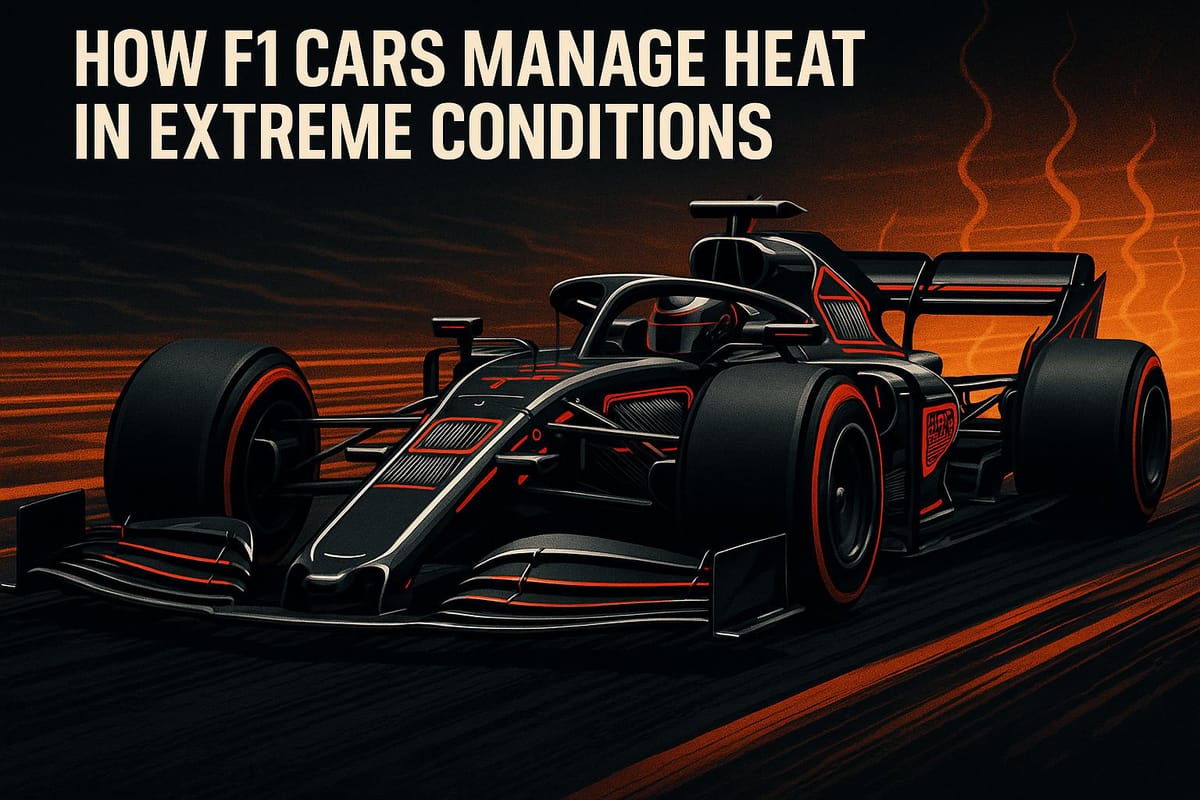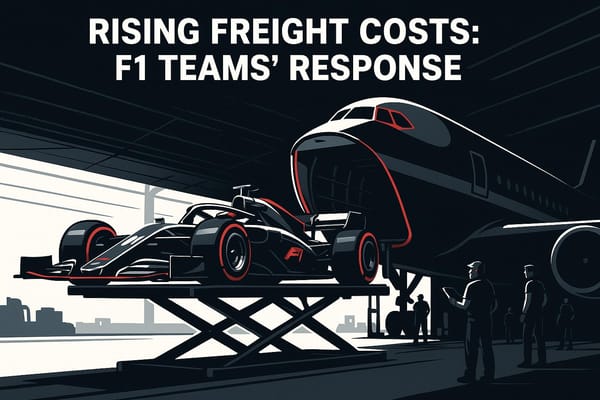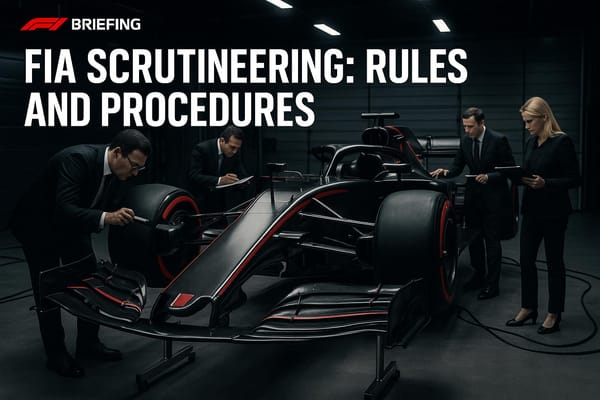How F1 Cars Manage Heat in Extreme Conditions
Explore how F1 cars tackle extreme heat with advanced cooling systems, innovative materials, and real-time telemetry to ensure performance and safety.

Formula 1 cars face extreme heat challenges, both from their powerful engines and external conditions like high ambient temperatures. Managing heat is critical for performance and safety, requiring advanced cooling systems, aerodynamic designs, and real-time monitoring. Key points include:
- Engines and hybrid systems generate immense heat, with combustion temperatures reaching 4,712°F.
- Cooling systems use radiators, heat exchangers, and advanced materials like ceramic coatings to dissipate heat efficiently within compact car designs.
- Driver safety is prioritized with cockpit cooling systems and FIA protocols for extreme heat, especially after incidents like the 2023 Qatar Grand Prix.
- Real-time telemetry helps teams adjust strategies during races to prevent overheating.
- Future regulations, like the 2026 removal of the MGU-H, will reshape cooling strategies, emphasizing efficiency and sustainability.
Heat management in F1 is a constant balancing act between cooling, aerodynamics, and reliability, with ongoing innovations shaping the sport's future.
How Hard Is It To Keep Cars Cool In Singapore? | F1 TV Tech Talk

Cooling Systems in F1 Cars
F1 cooling systems are engineering marvels, working tirelessly to keep temperatures in check under extreme conditions. These systems handle heat levels that would cripple standard cars, all while fitting into the compact designs required for optimal aerodynamics. Let’s take a closer look at the key components that make these systems so effective.
Main Components of Cooling Systems
At the heart of every F1 cooling system are carefully designed radiators, tucked into the sidepods to maximize airflow at high speeds. These radiators pull heat away from the engine and hybrid components using dedicated coolant circuits. Alongside them, heat exchangers regulate the temperature of critical fluids like oil and the compressed air feeding the turbocharger, while water pumps ensure a continuous flow of coolant through the engine block.
What sets these systems apart is their complexity. Multiple cooling circuits work in unison to manage the internal combustion engine, turbocharger, MGU-H, MGU-K, and energy store. The challenge? Squeezing all of this into sidepods that are getting slimmer with every new car design.
Cooling Power Units and Hybrid Systems
Modern F1 power units, with their hybrid systems, bring a whole new level of thermal complexity. For instance, the MGU-H, which recovers energy from exhaust gases, operates in an environment where temperatures can soar to an astonishing 4,712°F (2,600°C). Without proper cooling, these sensitive electrical components wouldn’t survive. Similarly, the MGU-K and high-voltage battery (Energy Store) require their own cooling solutions to maintain peak performance throughout a race.
To handle these diverse demands, teams use separate cooling circuits tailored to each component. These systems are intricately integrated, balancing the need for efficient heat management with the tight space constraints of an F1 car.
Advanced Materials and Coatings
The materials used in F1 cooling systems are just as impressive as the systems themselves. Heat-resistant alloys and ceramic coatings play a vital role, allowing components to operate closer to their thermal limits while staying protected. For example, ceramic coatings on exhaust systems and turbochargers contain extreme temperatures, minimizing unwanted heat transfer to nearby parts.
Radiators made from advanced aluminum alloys strike a balance between being lightweight and highly efficient at dissipating heat. Thermal barrier coatings on engine blocks and cylinder heads add insulation, enabling higher compression ratios and more aggressive performance settings without risking damage. On top of that, cutting-edge technologies like phase-change materials and additive manufacturing are pushing the boundaries of cooling efficiency and design flexibility even further.
Airflow and Aerodynamic Cooling Strategies
Keeping F1 cars from overheating isn’t just about having powerful cooling systems - it’s also about using smart aerodynamic designs to direct airflow exactly where it’s needed. Teams work to guide cool air to key components while keeping drag to a minimum. This delicate balance is achieved through clever sidepod designs, carefully placed vents, and precise airflow management that complements the advanced cooling systems discussed earlier.
Role of Sidepods, Radiators, and Brake Ducts
Sidepods play a dual role in F1 cars: they’re both aerodynamic tools and cooling hubs. Inside these compact structures, radiators and heat exchangers are arranged to make the most of limited space. By angling and shaping the radiators strategically, teams can maximize heat dissipation without creating too much drag.
However, pushing the boundaries of compact design isn’t without its challenges. At the 2023 Australian Grand Prix, several teams introduced sidepod designs with extremely tight internal layouts. These designs, while innovative, brought thermal challenges that led to further refinements.
Brake ducts are another critical component. Engineers carefully design these ducts to let in just the right amount of air - enough to keep the brakes cool without creating unnecessary drag. Too much airflow could slow the car down, while too little risks brake failure during intense braking moments.
Balancing Cooling with Aerodynamic Performance
One of the toughest challenges in F1 design is finding the sweet spot between cooling and aerodynamic performance. The temperatures inside an F1 engine’s combustion chamber can soar to an astonishing 4,712°F (2,600°C), making effective cooling non-negotiable. But increasing cooling capacity often comes at the cost of higher drag, which can slow the car down.
This trade-off forces teams to make strategic decisions. For instance, they might adjust the size of cooling inlets depending on the race conditions or even implement temporary cooling measures during particularly hot races. It’s all about managing the balance between keeping engine, hybrid, and brake temperatures safe while still pushing for maximum speed.
| Cooling Solution | Cooling Effectiveness | Aerodynamic Impact | Typical Use Case |
|---|---|---|---|
| Large sidepod inlets | High | High drag | Hot races, prioritizing reliability |
| Tight sidepod packaging | Lower | Low drag | Cooler races, focusing on performance |
| Additional vents/louvres | Moderate | Moderate drag | Targeted cooling with compromise |
In races with extreme heat - like the Singapore Grand Prix or the U.S. Grand Prix, where temperatures often exceed 88°F (31°C) - teams sometimes opt for maximum cooling setups. While this slightly increases drag, it ensures both the car’s reliability and the driver’s safety.
Venting and Heat Extraction Methods
Beyond managing airflow, F1 teams use innovative venting techniques to extract heat from the car. Features like louvres, gills, and vents on engine covers and sidepods help remove hot air from inside the car. These vents work alongside the car’s cooling circuits, creating a comprehensive heat management system. What’s more, these venting features are often modular, allowing teams to tweak or add vents based on the specific conditions of a race. For hotter events, teams might open additional vents to enhance heat extraction, even if it comes with a slight aerodynamic penalty.
Advanced tools like CFD simulations and wind tunnel testing ensure that these vent modifications don’t compromise the car’s structural integrity. The trend in F1 is moving toward smaller, more efficient cooling systems, with research into active cooling technologies and smart materials that respond to temperature changes paving the way for even more advanced solutions in future seasons.
Real-time monitoring also plays a critical role. Sensors track the temperatures of key components during races, sending telemetry data to engineers on the pit wall. This allows teams to guide drivers on pacing or make adjustments to avoid overheating. Together, these aerodynamic cooling strategies ensure that F1 cars maintain peak performance, even under the most demanding conditions.
Real-Time Heat Management During Races
Handling heat during an F1 race is all about quick thinking and precise action based on live data. Teams depend on cutting-edge telemetry systems that constantly track temperature readings, enabling them to tweak engine settings and driver strategies on the fly. These split-second decisions often make the difference between a strong finish and costly failures, whether mechanical or physical. This real-time decision-making builds on the advanced thermal designs and airflow techniques previously discussed.
Telemetry and Sensor-Based Monitoring
Today’s F1 cars are packed with telemetry systems that monitor over 300 data channels in real time. Temperature sensors are strategically placed on critical components like the engine, energy store, turbocharger, radiators, and brake ducts. This constant stream of data helps engineers spot temperature spikes instantly. For example, if brake temperatures climb during intense braking, teams can instruct drivers to adjust their braking style or racing line to improve cooling. Similarly, if engine parts are nearing unsafe heat levels, engineers may suggest switching to a lower power mode. This kind of predictive monitoring becomes even more vital when ambient temperatures exceed 87.8°F (31°C), the FIA’s threshold for declaring a "heat hazard".
Driver and Team Strategies for Heat Management
The data collected by sensors doesn’t just sit idle - it directly shapes both driver actions and team strategies. When temperatures start to soar, teams might call for a cooling lap, where the driver slows down briefly to let the car shed heat. While this can mean losing some ground, it prevents more severe issues like overheating. Another option is adjusting engine modes to lower heat output, though this comes at the cost of reduced performance.
In extreme heat, drivers have even had to retire from races due to exhaustion caused by high temperatures. These incidents led to the FIA introducing the "heat hazard" protocol to protect drivers in such conditions.
Driver cooling systems also play a big role in combating heat. Cooling vests, which circulate chilled fluid under the driver’s suit, are now a regular feature in extreme conditions. However, these systems aren’t foolproof. The cramped cockpit can cause the tubes to crimp, and if the system fails, the vest might circulate hot liquid instead, worsening the situation. At the 2024 Singapore Grand Prix, several drivers, including Mercedes’ George Russell, wore cooling vests during the race. Russell noted improved comfort, even though drivers choosing not to use the system had ballast added to their cars to maintain competitive fairness.
| Heat Management Strategy | Performance Impact | Reliability Benefit | When Used |
|---|---|---|---|
| Cooling laps | Slower lap times | Prevents overheating | High component temps |
| Lower engine modes | Reduced power output | Less heat generation | Power unit stress |
| Cooling vests | Added weight | Driver comfort/safety | Extreme ambient heat |
Driver preparation is another key element of heat management. Many drivers undergo heat acclimatization training, such as spending time in saunas, to help their bodies adapt to the intense temperatures they’ll face on race day. This training ensures they stay sharp and focused despite the physical demands.
The FIA is actively working with teams and drivers to refine heat management rules, aiming to balance safety with competitive fairness. While the use of cooling vests is currently optional, there’s talk of making them mandatory in extreme conditions starting in 2026.
Real-time heat management stands out as one of the toughest challenges in modern F1 racing. It requires flawless coordination between advanced telemetry, quick decision-making from the pit wall, and adaptable driver strategies to maintain both performance and safety under grueling conditions.
Future Trends in F1 Heat Management
As we look ahead, the way Formula 1 cars handle heat is set to undergo significant changes. With the upcoming 2026 regulations and a growing focus on sustainability, teams are pouring resources into advanced cooling technologies. These innovations aim to improve efficiency while aligning with F1's environmental goals, building upon the thermal solutions already in place.
Developments in Hybrid Cooling Systems
One of the most notable changes on the horizon is the removal of the MGU-H (Motor Generator Unit – Heat) from power units under the 2026 technical regulations. This shift will simplify energy systems but also change the thermal load profiles of F1 cars, requiring engineers to rethink their cooling architectures. The absence of the MGU-H eliminates a key component that recovers exhaust energy, pushing teams to redesign systems with a focus on simplicity and efficiency.
To address these challenges, advanced dielectric fluids are being used to cool high-voltage hybrid components. These fluids are non-conductive, making them ideal for managing the electrical systems in hybrid power units. In addition, modern liquid cooling circuits are enhancing performance, while cutting-edge radiator designs are leveraging innovative coolant chemistries to improve heat transfer and reduce weight. This ensures that even as powertrain temperatures rise, performance remains steady.
These advancements in hybrid cooling naturally pave the way for breakthroughs in materials and energy management.
New Materials and Energy Solutions
Materials like carbon composites with high thermal conductivity are becoming a game-changer. They offer lightweight yet effective heat transfer solutions, enabling more compact cooling systems without compromising performance. Similarly, ceramic coatings on exhausts and turbochargers are proving invaluable. These coatings can withstand extreme temperatures while minimizing unwanted heat transfer to other components.
Another exciting development is the use of phase-change materials. These materials absorb and release heat during temperature spikes, acting as thermal buffers to maintain stable operating conditions during races. This ability to smooth out temperature fluctuations is particularly useful in the high-stress environment of F1.
The sport's commitment to 100% sustainable fuels by 2026 is also driving energy-efficient innovations like electric water pumps and variable-speed fans. These technologies reduce energy losses while maintaining precise thermal control. On top of that, low-global-warming-potential (GWP) coolants and recyclable materials are being adopted to align with F1's environmental objectives.
Adapting to Future Technical Regulations
As new cooling technologies and materials emerge, regulatory changes will continue to shape thermal management strategies. Future rules are expected to impose stricter limits on power unit efficiency, energy recovery, and overall car weight. Teams will need to design cooling systems that not only meet these requirements but also maintain competitive performance. For example, while driver cooling vests won't be mandatory in 2025, they could become required for heat-intensive races starting in 2026. This would enhance driver safety while still allowing room for technical innovation.
AI-driven predictive analytics is another area gaining traction. Teams are using these tools to predict thermal spikes and proactively manage cooling resources, ensuring optimal performance under varying conditions.
The advancements in F1 thermal management today are not just confined to the racetrack. High-efficiency hybrid cooling systems, innovative materials, and real-time data analytics are already influencing automotive technologies beyond motorsports. As Formula 1 continues to push engineering boundaries, these developments will play a key role in shaping the future of the automotive industry.
Conclusion: Mastering Heat Management in Formula 1

Managing heat in Formula 1 isn't just an engineering puzzle - it's a race-defining challenge. During grueling races, cockpit temperatures can soar beyond 104°F (40°C), forcing teams to walk a fine line between ensuring peak performance and protecting the drivers' well-being.
To tackle these challenges, teams rely on a mix of advanced cooling systems and aerodynamic tweaks designed to channel heat away from power units, hybrid components, and the driver’s cockpit. But there’s always a trade-off. For instance, while larger radiator inlets can help with heat dissipation, they also increase drag, cutting into straight-line speed.
In recent years, extreme race conditions have pushed drivers to their limits, even leading to heat-related failures. To address this, the FIA introduced heat hazard declarations, setting a threshold at 87.8°F (31°C) ambient temperature. Teams now use real-time telemetry to monitor and adjust engine modes, airflow, and other variables to keep temperatures in check during races.
Looking toward the future, thermal management is only going to get trickier. As power units become more efficient and compact, the resulting heat density will rise, squeezing teams to find innovative cooling solutions within tighter packaging. The removal of the MGU-H system in 2026 will further shake things up, requiring teams to rethink their entire approach to cooling architectures.
Success in Formula 1 increasingly depends on mastering these thermal challenges. Striking the right balance between cooling and aerodynamics, while safeguarding drivers, gives teams a real edge. As the sport continues to push engineering boundaries, heat management has become a key factor that separates the frontrunners from the rest.
For newer teams entering the grid, the takeaway is simple: mastering thermal management is just as critical as aerodynamics and power unit design.
FAQs
How do F1 teams keep their cars cool without sacrificing aerodynamic performance?
Formula 1 teams tackle the intense heat generated by their cars with a mix of cutting-edge cooling systems and smart aerodynamic designs. They use precisely engineered air intakes, radiators, and heat exchangers to channel airflow directly to vital parts like the engine and brakes. These components are fine-tuned to shed heat efficiently while keeping aerodynamic drag as low as possible, maintaining both speed and performance.
In addition, teams incorporate advanced materials and thermal coatings to keep heat buildup under control. By striking the right balance between airflow and temperature management, they ensure the cars stay reliable in extreme conditions without sacrificing speed or agility.
How do F1 cars handle extreme heat during races like the Singapore Grand Prix?
Formula 1 cars face intense challenges with heat management during races held in scorching, humid climates like Singapore. These extreme conditions can strain engine components, brakes, and tires, pushing them to their breaking point and threatening performance if not carefully controlled.
To tackle this, teams rely on highly sophisticated cooling systems. They design radiators and ducts to optimize airflow, ensuring critical components stay within safe temperature ranges. Aerodynamic features like sidepods and vents are meticulously adjusted to direct air effectively while keeping drag to a minimum. On top of that, teams continuously monitor real-time data, tweaking strategies as needed to keep the car performing at its best, even under the harshest conditions.
How will removing the MGU-H in 2026 impact F1 car cooling systems and design?
The decision to eliminate the MGU-H (Motor Generator Unit-Heat) from Formula 1 power units in 2026 is set to shake up how teams handle cooling and overall car design. Right now, the MGU-H plays a crucial role by converting exhaust heat into electrical energy. Without it, teams will face new challenges in managing the extra heat produced by the power unit. This could push them to develop larger or more efficient cooling systems to deal with the added thermal demands.
On top of that, removing the MGU-H might simplify engine designs. This reduction in complexity could lead to lighter engines and open the door for fresh aerodynamic strategies. Teams will need to get creative, balancing performance needs with the sport's ever-evolving technical rules.




